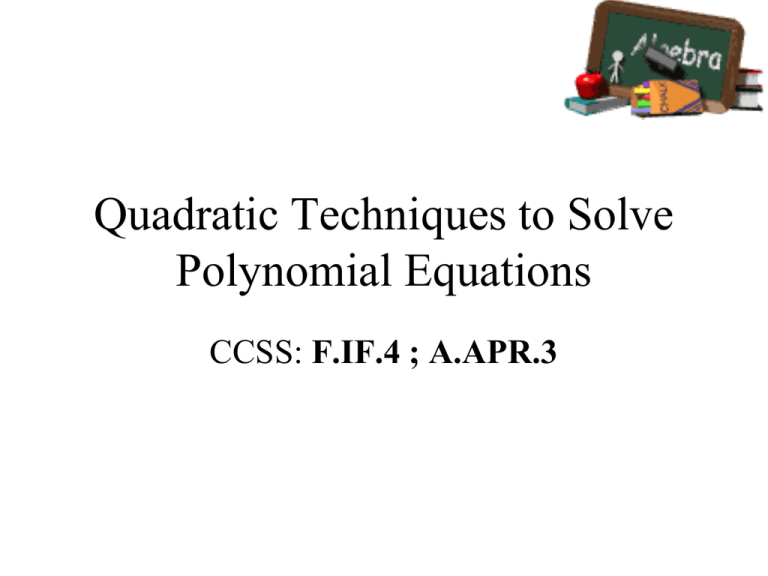7.6 Quadratic Techniques to Solve Polynomial Equations
advertisement

Quadratic Techniques to Solve Polynomial Equations CCSS: F.IF.4 ; A.APR.3 CCSS: F.IF.4 • For a function that models a relationship between two quantities, interpret key features of graphs and tables in terms of the quantities, and sketch graphs showing key features given a verbal description of the relationship. Key features include: intercepts; intervals where the function is increasing, decreasing, positive, or negative; relative maximums and minimums. CCSS: A.APR.3 • Identify zeros of polynomials when suitable factorizations are available, and use the zeros to construct a rough graph of the function defined by the polynomial. Standards for Mathematical Practice • 1. Make sense of problems and persevere in solving them. • 2. Reason abstractly and quantitatively. • 3. Construct viable arguments and critique the reasoning of others. • 4. Model with mathematics. • 5. Use appropriate tools strategically. • 6. Attend to precision. • 7. Look for and make use of structure. • 8. Look for and express regularity in repeated reasoning. Essential Question: • How do we use quadratic techniques solving equations? Objectives • Solve third and fourth degree equations that contain quadratic factors, and • Solve other non-quadratic equations that can be written in quadratic form. Intro • Some equations are not quadratic but can be written in a form that resembles a quadratic equation. For example, the equation x4 – 20x2 + 64 = 0 can be written as (x2)2 – 20x2 + 64 = 0. Equations that can be written this way are said to be equations in quadratic form. Key Concept: • An expression that is quadratic form can be written as: • au² +bu + c for any numbers a, b, and c, a≠0, where u is some expression in x. • The expression au² +bu + c is called quadratic form of the original expression. Once an equation is written in quadratic form, it can be solved by the methods you have already learned to use for solving quadratic equations. Ex. 1: Solve x4 – 13x2 + 36 = 0 x 4 13x 2 36 0 ( x 2 ) 2 13( x 2 ) 36 0 ( x 2 9)( x 2 4) 0 ( x 3)( x 3)( x 2)( x 2) 0 x3 0 x 3 x 3 0 x3 x20 x 2 x2 0 x2 The solutions or roots are -3, 3, -2, and 2. The graph of x4 – 13x2 + 36 = 0 looks like: The graph of y = x4 – 13x2 + 36 crosses the x-axis 4 times. There will be 4 real solutions. • Recall that (am)n = amn for any positive number a and any rational numbers n and m. This property of exponents that you learned in chapter 5 is often used when solving equations. Ex. 2: Solve 1 2 1 2 1 4 x 6x 8 0 1 4 x 6x 8 0 1 4 2 1 4 ( x ) 6( x ) 8 0 1 4 1 4 ( x 2)( x 4) 0 1 check 4 check 1 2 1 4 x 6x 8 0 1 2 1 4 16 6(16 ) 8 0 4 6( 2) 8 0 ? 4 12 8 0 ? 12 12 0 00 1 2 1 4 x 2 0 ( x 4) 0 1 4 x 6x 8 0 1 4 2 )8 0 256 x 6(256 16 6(41) 8 0 ? 1 2 1 4 4 04? 24 (24 x ) 00 x 16 (2) 4 1 4 x 4 1 4 4 ( x ) 44 x 256 2 3 Ex. 3: Solve t 16 2 3 t 16 2 3 3 (t ) (16) 3 t 2 163 or 4 6 1 6 2 t (4 ) t 43 or 64 check 2 3 t 16 2 3 check 2 3 t 16 2 3 64 16 ? (64) 16 ? (3 64 ) 2 16 ? (3 64 ) 2 16 ? 4 2 16 ? 16 16 (4) 2 16 ? 16 16 Ex. 4: Solve x 7 x 8 0 x 7 x 8 0 ( x ) 2 7( x ) 8 0 b b 2 4ac x 2a (7 (7) 2 4(1)( 8) x 2(1) 7 81 2 7 9 16 8 2 2 79 2 1 2 2 x 8 ( x) 8 x 64 2 2 Ex. 4: Solve x 7 x 8 0 check x 7 x 8 0 64 7 64 8 0 64 7(8) 8 0 64 56 8 0 00 There is no real number x such that is = - x 1 1.Since principal root of a number can not be negative, -1 is not a solution. The only solution would be 64. • Some cubic equations can be solved using the quadratic formula. First a binomial factor must be found. Ex. 5: Solve x 27 0 3 x 27 0 x 2 3x 9 0 ( x 3)( x 3 x 9) x 3 0 b b 2 4ac 2a 3 2 x3 3 32 4(1)(9) 2(1) 3 9 36 2 3 27 2 3 3i 3 2 Quadratic form ax2 + bx + c = 0 2x2 – 3x – 5 = 0 This also would be a quadratic form of an equation 2 y 4 3 y 2 5 0 or 2x 3 x 5 0 or 2 3 1 3 2 x 3x 5 0 How would you solve 2 y 3y 5 0 or 4 2 2x 3 x 5 0 or 2 3 1 3 2 x 3x 5 0 Use Substitution How would you solve 2y 3y 5 0 4 2 2u 3u 5 0 2 Use Substitution Let u = y2 u2 = y4 How would you solve 2u 3u 5 0 2 2u 5u 1 0 5 u ; u 1 2 Use Substitution Let u = y2 u2 = y4 How would you solve 5 u ; u 1 5 2 2 2 Then y ; y 1 Use Substitution 2 Let u = y2 2 = y4 u 5 y ; y 1 2 10 y ; y i 2 How would you solve Then 5 u ; u 1 2 5 x ; 2 x 1 25 x ; x 1 4 Use Substitution Let u x u2 x Do both answers work? How would you solve 5 u ; u 1 2 Then 2 x 3 x 5 0 Use Substitution Let u x 2 25 25 u x 2 3 5 4 4 Do both answers 25 5 work? 3 5 2 2 25 15 10 0 2 2 2 21 3 1 5 0 How would you solve Then 1 3 1 3 5 x 2 3 5 x 2 1 3 125 x 8 x 1 3 3 Use Substitution Let u x 13 3 x 1 x 1 5 u ; u 1 2 1 3 u x 2 2 3 How would you solve 5 u ; u 1 2 Then Use Substitution 2 1 Let u x 125 3 125 3 2 3 5 0 8 8 u x Do both answers work? 2 1 2(1) 3 3(1) 3 5 0 1 3 2 2 3






